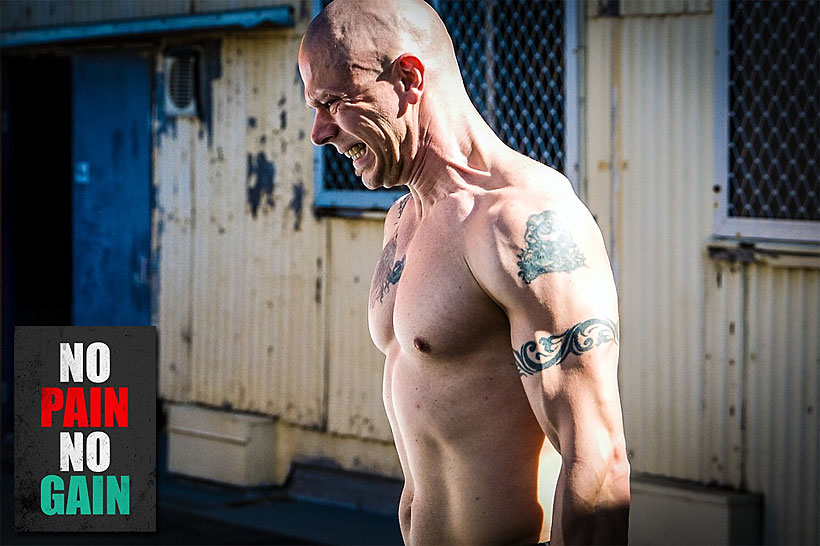- Like
- SHARE
- Digg
- Del
- Tumblr
- VKontakte
- Flattr
- Buffer
- Love This
- Save
- Odnoklassniki
- Meneame
- Blogger
- Amazon
- Yahoo Mail
- Gmail
- AOL
- Newsvine
- HackerNews
- Evernote
- MySpace
- Mail.ru
- Viadeo
- Line
- Comments
- Yummly
- SMS
- Viber
- Telegram
- JOIN
- Skype
- Facebook Messenger
- Kakao
- LiveJournal
- Yammer
- Edgar
- Fintel
- Mix
- Instapaper
- Copy Link
 When it comes to the never-ending onslaught of fitness advice that pervades gyms, fitness studios, and, of course, the internet, it can be difficult to cull through the good and the bad. Don’t miss this essential guide to the most popular pieces of fitness advice you should ignore.
When it comes to the never-ending onslaught of fitness advice that pervades gyms, fitness studios, and, of course, the internet, it can be difficult to cull through the good and the bad. Don’t miss this essential guide to the most popular pieces of fitness advice you should ignore.
#1. No pain, no gain.
If your sense of accomplishment when it comes to working out is tied up with any degree of pain you may be feeling, you have been misled by poor fitness advice. Pain and discomfort should never be the hallmarks of a successful exercise program; rather, they are oftentimes your body’s way of raising a red flag.
While delayed onset muscle soreness is normal in the 48 to 72 hours following an intense exercise program, when it lasts longer than 5 to 7 days, you may have a problem. Same goes for stabbing, sharp, or radiating pain that accompanies your movements during exercise. The “no pain, no gain” advice should be replaced by “listen to your body.” Your own body-consciousness will do more to help you prevent injuries than a desire to shred your muscles (and potentially your other soft tissues). For example, acknowledging and addressing recurring foot and leg pain when you work out could help prevent a serious injury that sidelines your workout routine altogether.
#2. Muscle weighs more than fat.
This old adage is often inserted into conversations attempting to explain why a routine exercise regimen hasn’t resulted in any weight loss. Obviously, a pound is a pound, no matter what material it’s composed of. Though muscle doesn’t weigh more than fat, it is denser than fat, which means that it takes up less room on your skeleton than fat does.
Muscle tissue also burns more calories than fat tissue and the very creation of muscle also eats up a lot of calories according to the American Council on Exercise. Therefore, the notion that replacing fat with muscle will increase your basal metabolic rate (the rate at which your body burns calories while at rest) bodes true.
#3. You should weigh _______.
Expert trainers know that body composition varies from person to person so there is never a number on a scale that you should be told you should weigh. While your weight can be a guide for improving your own health and wellness, so can important aspects like the inches of actual tissue on your body, your sense of comfort and confidence, and vital health metrics like blood pressure, resting heart rate, and respiratory rate.
Researchers have also found that body types characterized by waist-size, i.e. pear-shapes that have more fat around the hips and thighs and apple-shapes that have more fat around the abdomen, provide greater insight into the risk levels of future health problems. For example, one study found that women considered to have a “normal weight” (body mass index less than 25) but who carried more weight around their waist were more likely to die from heart disease than those at a “normal weight” who didn’t.
#4. There’s one perfect approach to certain exercises.
While good form plays a critical role in preventing injury when it comes to weight lifting, running, and exercise movements like lunges, squats, and planks, for example, your approach to them may still differ from the next person. Why?
Many factors can influence your need to modify exercises so they are safer and more accessible for you – this may include your age, previous injury, your workout environment, and your movement history. The “ideal push-up” may not be so ideal for you and that’s ok. To achieve the best form and facilitate the most effective body mechanics, start a dialogue with your trainer who can evaluate your abilities in-person and make recommendations accordingly.
#5. You burn more fat during longer periods of low-intensity aerobic exercise that shorter period of high-intensity exercise.
The rise in popularity of high-intensity interval training (HIIT) has slowly helped dispel this myth in part by encouraging researchers to evaluate the two with more comparative scientific studies. What have they found? Shorter bouts of high-intensity exercise not only burn more calories but on a physiological scale they also induce powerful health-boosting adaptations in the body like improved insulin sensitivity and increased muscle oxidative capacity.
This isn’t to say that endurance-based low and moderate-intensity exercises aren’t important or effective. Long bouts of aerobic exercise also generate numerous weight management and health benefits and help adults reach the 150 minutes of moderate exercise a week that is recommended by the Department of Health and Human Services. The advice that it is more effective than HIIT is misinformed, however. Bottom line: no matter what you do, find fitness programs that keep you moving and encourage you to exercise regularly.

